The content landscape in 2025 is more competitive than ever. To keep up, marketers are turning to powerful solutions to streamline workflows, from ideation and creation to distribution and analysis. Content automation tools are no longer a luxury; they are a necessity for scaling operations, maintaining consistency, and freeing up valuable time for strategic thinking. But selecting the right platform from a sea of options can feel overwhelming.
This guide cuts through the noise. We've compiled a comprehensive list of the leading content automation platforms, from AI writers like Writesonic to social media managers like Hootsuite and all-in-one marketing hubs like HubSpot. Instead of generic feature lists, we provide an honest assessment of what makes each tool unique. Before diving into the specifics of automation, it's essential to have a well-defined content marketing strategy that aligns with your overall business objectives.
Our goal is to help you find the best fit for your specific needs, whether you're an entrepreneur looking to generate blog posts or a marketing team aiming to manage a complex content calendar. For each tool, you will find:
- Practical Use Cases: Discover how these platforms solve real-world problems.
- In-Depth Analysis: A look at key features, pros, and cons.
- Pricing & Implementation: Clear insights into cost and setup.
- Screenshots & Direct Links: See the tools in action and access them easily.
This resource is designed to be your definitive guide to choosing the right content automation tools to drive traffic and grow your business. Let's explore the platforms that will power your 2025 marketing efforts.
1. rebelgrowth
rebelgrowth establishes itself as a premier, all-in-one solution among content automation tools, distinguishing itself by blending powerful AI with expert human oversight. It's not just a tool; it's a comprehensive, done-for-you growth engine designed for entrepreneurs and marketing teams who need to scale their SEO and content marketing without the typical complexities. The platform’s core strength lies in its integrated approach, combining automated content creation with strategic, high-touch services like backlink building and market analysis.
This unique hybrid model allows businesses to put their content marketing on autopilot while still benefiting from a strategy crafted by seasoned experts. Instead of just generating articles, rebelgrowth builds a complete content ecosystem designed for sustainable growth, making it a formidable partner for achieving tangible business outcomes like increased traffic and higher search rankings.
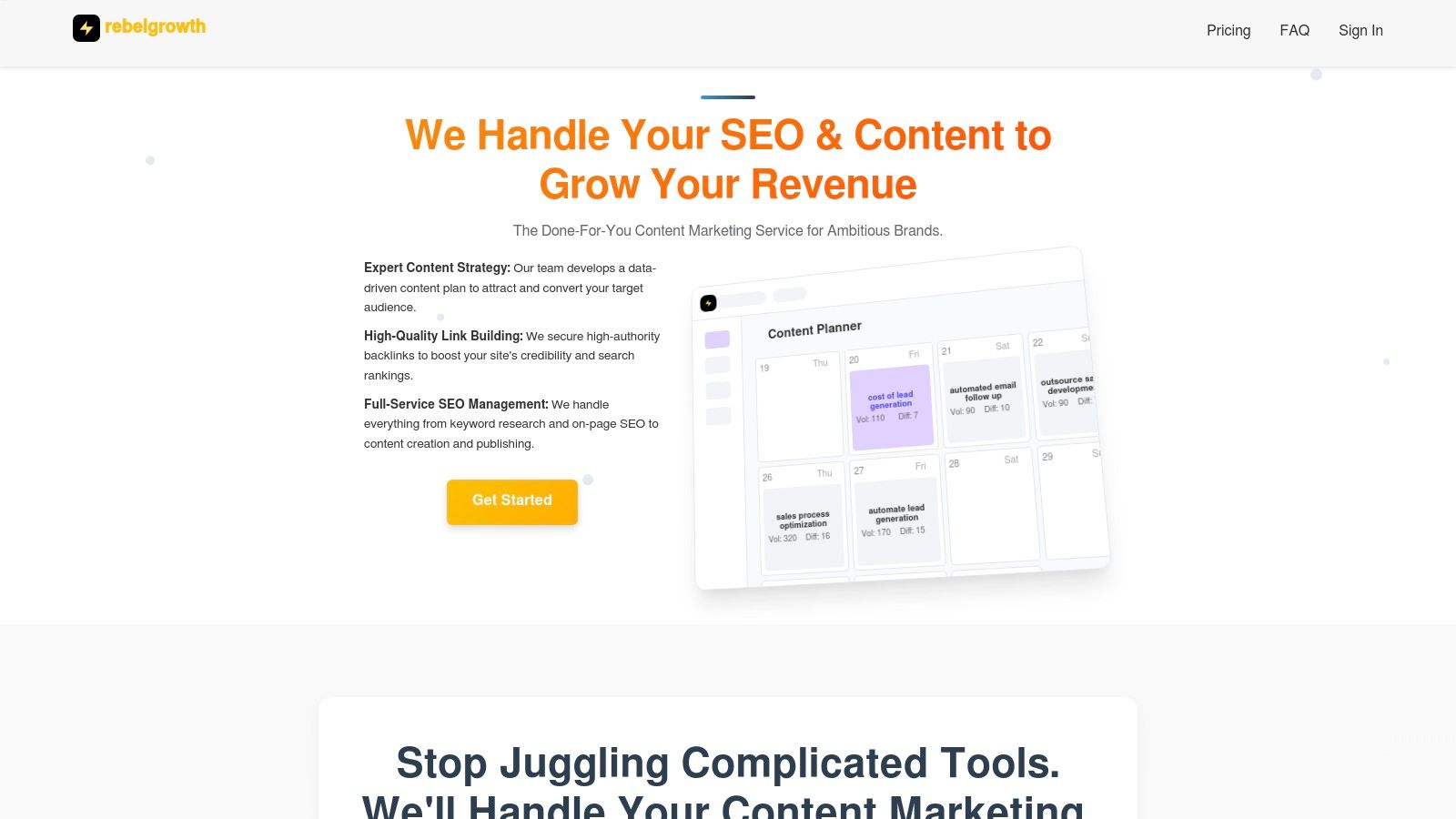
Key Features & Analysis
rebelgrowth excels by integrating multiple marketing functions into a single, cohesive platform. This eliminates the need to subscribe to and manage several disparate tools for SEO, content creation, and social media.
- AI-Driven & Expert-Led Content: The platform automatically generates daily, SEO-optimized blog posts based on deep keyword research and market analysis conducted by its team. Clients retain full control, with the ability to review and edit all AI-generated content before it goes live.
- Integrated Backlink Exchange: A standout feature is the built-in backlink exchange network. This provides a crucial, often difficult-to-manage, component of SEO by facilitating high-quality link building, directly boosting domain authority and search rankings.
- Multi-Channel Automation: Beyond the blog, rebelgrowth uses AI to create and schedule social media content, ensuring a consistent brand presence across all major channels.
- Broad Compatibility & Global Reach: With seamless integrations for WordPress, Shopify, Wix, and other major platforms, implementation is straightforward. Support for over 150 languages makes it an ideal choice for businesses targeting a global audience.
Expert Insight: The true value of rebelgrowth is its ability to deliver a full-service content strategy, not just automated blog posts. The combination of AI efficiency and human expertise ensures that the content is not only consistent but also strategically aligned with business goals, a feature often missing from purely AI-driven tools.
Use Cases & Implementation
rebelgrowth is particularly effective for:
- Small to Medium-Sized Businesses (SMBs): Companies without a large in-house marketing team can leverage rebelgrowth to compete with larger players by implementing a consistent, high-quality content and SEO strategy.
- Marketing Agencies: Agencies can manage multiple client websites from a single dashboard, streamlining content delivery and reporting while scaling their service offerings.
- E-commerce Stores: Shopify and Wix users can directly integrate the platform to drive organic traffic through targeted blog content that attracts their ideal customers.
Getting started involves an initial setup where the rebelgrowth team analyzes your business and develops a custom content strategy. While this requires a small time investment upfront, it ensures the subsequent automated content is highly relevant and effective. You can explore their strategic approach further by checking out the content on the rebelgrowth blog.
Pricing & Plans
rebelgrowth offers a transparent pricing structure designed to accommodate businesses of various sizes.
| Plan Tier | Key Features | Best For |
|---|---|---|
| Starter | AI blog generation, social media automation, standard support | Startups and solo entrepreneurs |
| Pro | All Starter features, plus backlink exchange, expert strategy, priority support | Growing businesses and agencies |
Plans begin at $59/month, providing an accessible entry point for comprehensive content automation.
Pros: * Automates daily SEO-optimized blog content for consistent traffic growth. * Includes expert-backed strategy and high-quality backlink building. * Supports multi-site management and integrates with popular CMS platforms. * Offers AI-driven social media creation and scheduling. * Provides content in over 150 languages for global reach.
Cons: * Initial setup requires some time for strategic customization. * Advanced features like priority support are reserved for higher-tier plans.
Website: https://rebelgrowth.com
2. HubSpot
HubSpot is less of a single tool and more of an entire marketing ecosystem. It positions itself as an all-in-one platform where content creation, automation, and customer relationship management (CRM) converge. While many tools focus on a specific niche, HubSpot's unique value proposition is its ability to tie every piece of content directly to a lead or customer in its powerful, free CRM. This integration allows for a level of personalization and tracking that standalone tools cannot match.
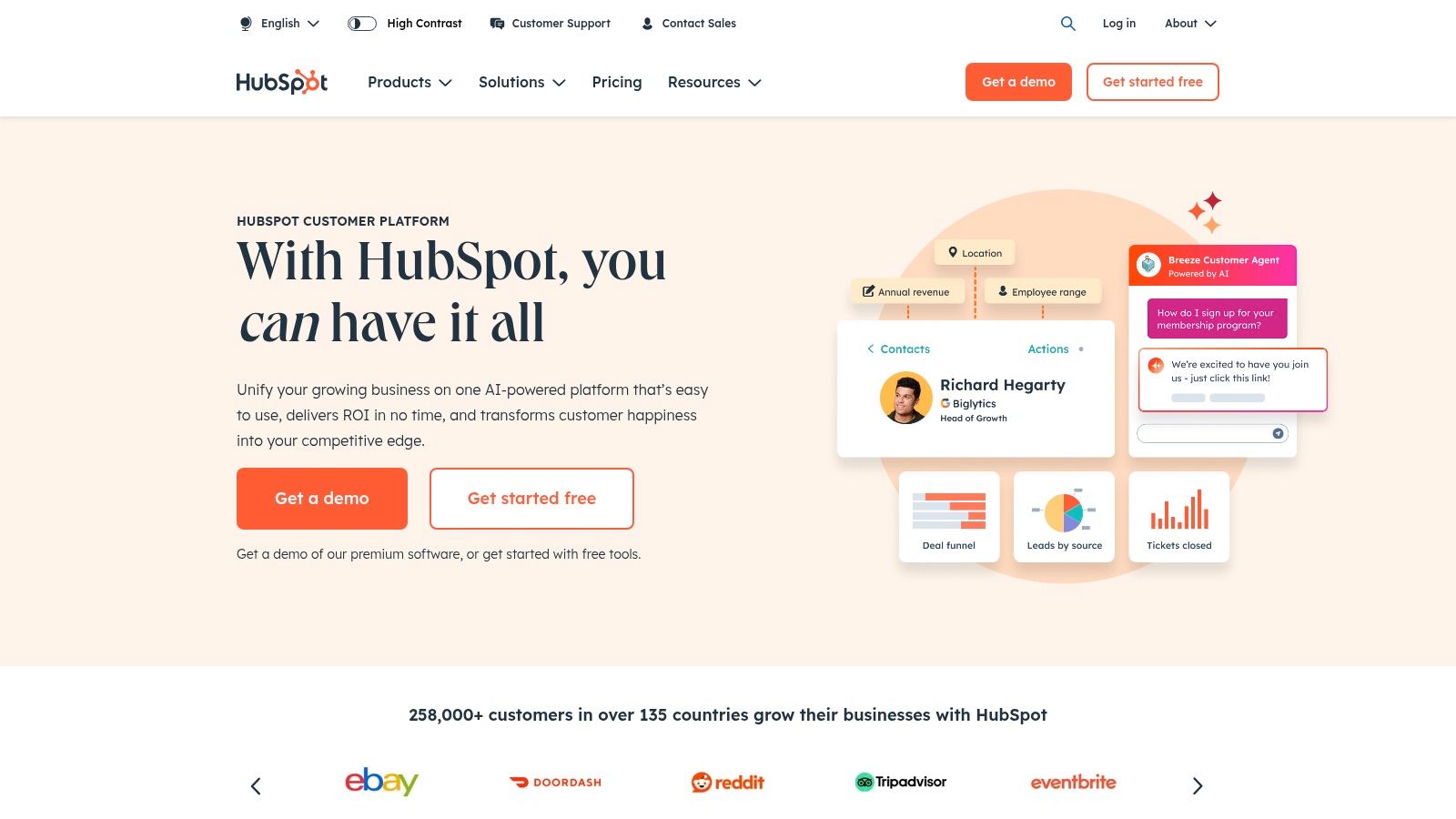
Core Features & Use Cases
HubSpot's Marketing Hub is where its content automation tools truly shine. You can build entire marketing campaigns, from blog post creation and SEO optimization to social media scheduling and automated email nurturing sequences, all within one interface. For instance, a user can publish a blog post, automatically promote it across social channels, and then trigger an email workflow for anyone who downloads a related content offer, all without leaving the platform.
Pricing and Accessibility
HubSpot offers a tiered pricing model that can be both a pro and a con. It provides a generous free tier with basic tools, making it accessible for startups to get started. However, to unlock its more powerful automation features, you'll need to subscribe to paid plans (Starter, Professional, Enterprise), which can represent a significant investment, especially for smaller businesses.
Practical Tip: Start with HubSpot's free CRM and marketing tools. This allows you to centralize your contacts and test basic features before committing to a paid plan. Understand your specific automation needs to ensure you choose the right tier without overpaying for features you won't use.
- Pros: Comprehensive feature set, seamless CRM integration, powerful analytics and reporting.
- Cons: Can be expensive for small businesses, steep learning curve due to its extensive capabilities.
Website: https://www.hubspot.com/
3. Hootsuite
Hootsuite is one of the most established names in social media management, carving out its niche by focusing almost exclusively on social content automation. Unlike all-in-one marketing platforms, Hootsuite’s strength lies in its specialized, comprehensive toolkit for planning, scheduling, and analyzing content across dozens of social networks from a single dashboard. This makes it an indispensable tool for social media managers and teams who need to execute complex social strategies with efficiency and precision.
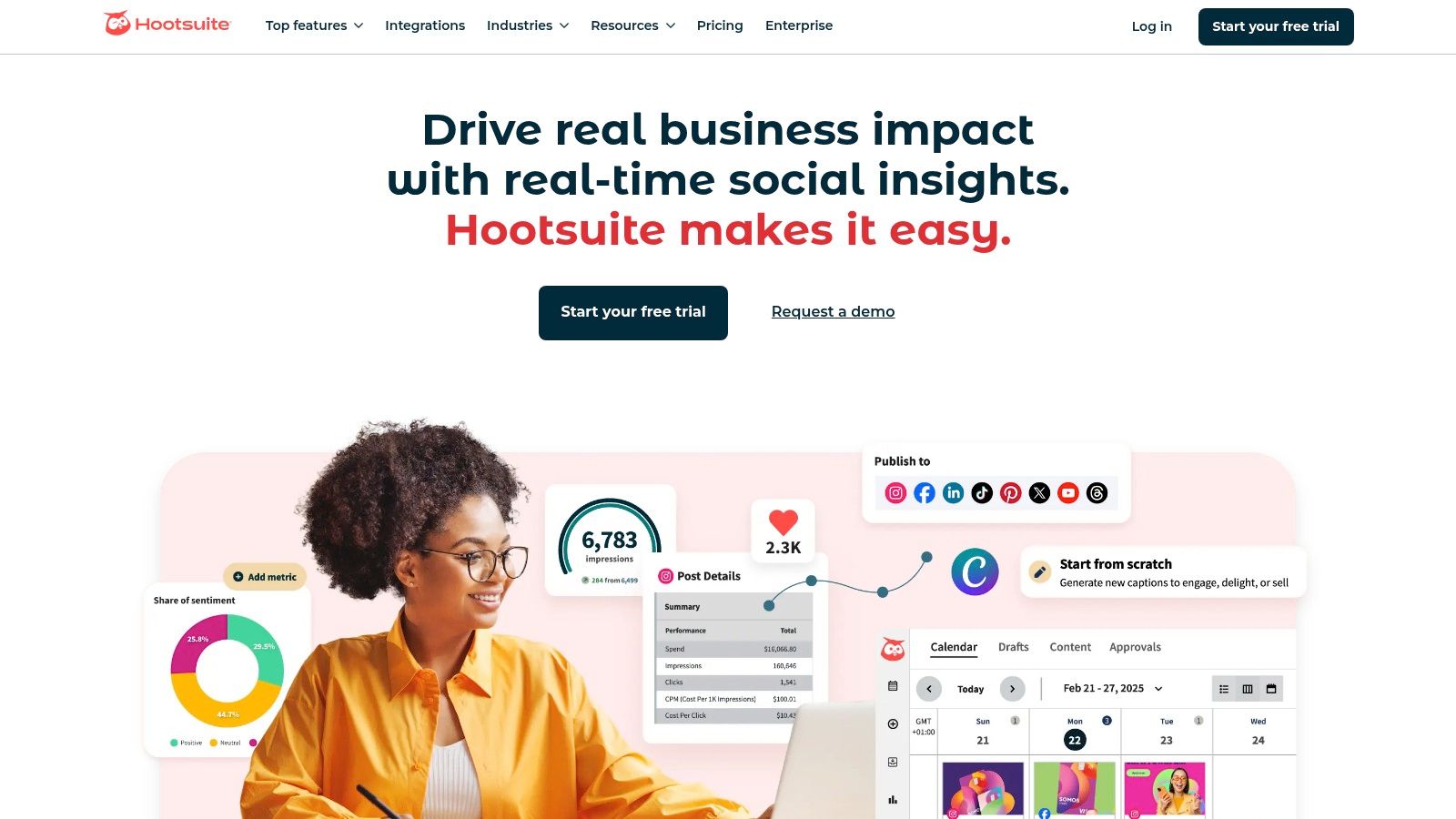
Core Features & Use Cases
Hootsuite’s core functionality revolves around its powerful post scheduler and content calendar. Users can bulk-schedule hundreds of posts at once, allowing them to map out their social content for weeks or months in advance. The platform also includes excellent content curation tools, suggesting relevant articles and posts to share, which helps keep social feeds active. For teams, its collaboration features allow for draft approvals and permission settings, ensuring brand consistency. These content automation tools are designed specifically to streamline the demanding workflow of social media marketing.
Pricing and Accessibility
Hootsuite offers several pricing tiers, including Professional, Team, and Business plans, catering to individuals, small teams, and large organizations respectively. A limited free plan used to be available, but it has been phased out in favor of a 30-day free trial for its paid plans. While its entry-level plans are reasonably priced, costs can escalate for teams needing more advanced analytics, user seats, and social accounts, positioning it as a premium option in the market.
Practical Tip: Use the "Best Time to Publish" feature, which analyzes your past engagement to recommend optimal posting times for each social network. This data-driven approach can significantly boost the visibility and impact of your automated content without extra effort.
- Pros: User-friendly interface, excellent for managing multiple social media accounts, strong content curation features.
- Cons: Limited features for other content types (e.g., blogs, emails), can be more expensive than some competitors.
Website: https://www.hootsuite.com/
4. Buffer
Buffer is a highly focused and streamlined tool designed to simplify one of the most time-consuming aspects of content marketing: social media management. Unlike all-in-one platforms, Buffer’s strength lies in its simplicity and dedication to doing one thing exceptionally well. It allows marketers and small business owners to automate their social media posting schedules across multiple platforms from a single, clean dashboard, saving significant time and ensuring a consistent online presence.
Core Features & Use Cases
Buffer excels at social media scheduling and analytics. Its core function allows you to create a queue of content and set a predefined posting schedule for each connected social profile (like X, Facebook, Instagram, LinkedIn, and Pinterest). A key use case is for a small business owner who can dedicate one hour on a Monday to schedule an entire week's worth of social media content. The platform's content automation tools then publish these posts at the optimal times without further manual intervention. It also offers features for team collaboration and, crucially, analytics to track post performance and refine your strategy.
Pricing and Accessibility
Buffer is known for its accessible pricing, making it a favorite among freelancers, startups, and small businesses. It offers a free plan that allows for basic scheduling on up to three channels, which is perfect for getting started. Paid plans (Essentials, Team, Agency) unlock more channels, deeper analytics, and collaboration features at a much lower price point than many of its more complex competitors. This straightforward pricing makes it easy to adopt without a large financial commitment.
Practical Tip: Use Buffer's browser extension and mobile app to add content to your queue on the fly. When you find an interesting article or have a sudden idea, you can add it to your schedule in seconds, ensuring your content pipeline never runs dry.
- Pros: Simple and intuitive interface, affordable pricing, excellent mobile app for on-the-go management.
- Cons: Limited features beyond social media, analytics are less robust than enterprise-level tools.
Website: https://buffer.com/
5. CoSchedule
CoSchedule is best known as a powerful marketing calendar and organizational tool that brings an entire content strategy into a single, unified view. Its unique strength lies in visualization and team coordination. While other platforms might focus on AI generation, CoSchedule excels at managing the human element of content creation, making it one of the premier content automation tools for teams that need to orchestrate complex editorial and social media schedules.
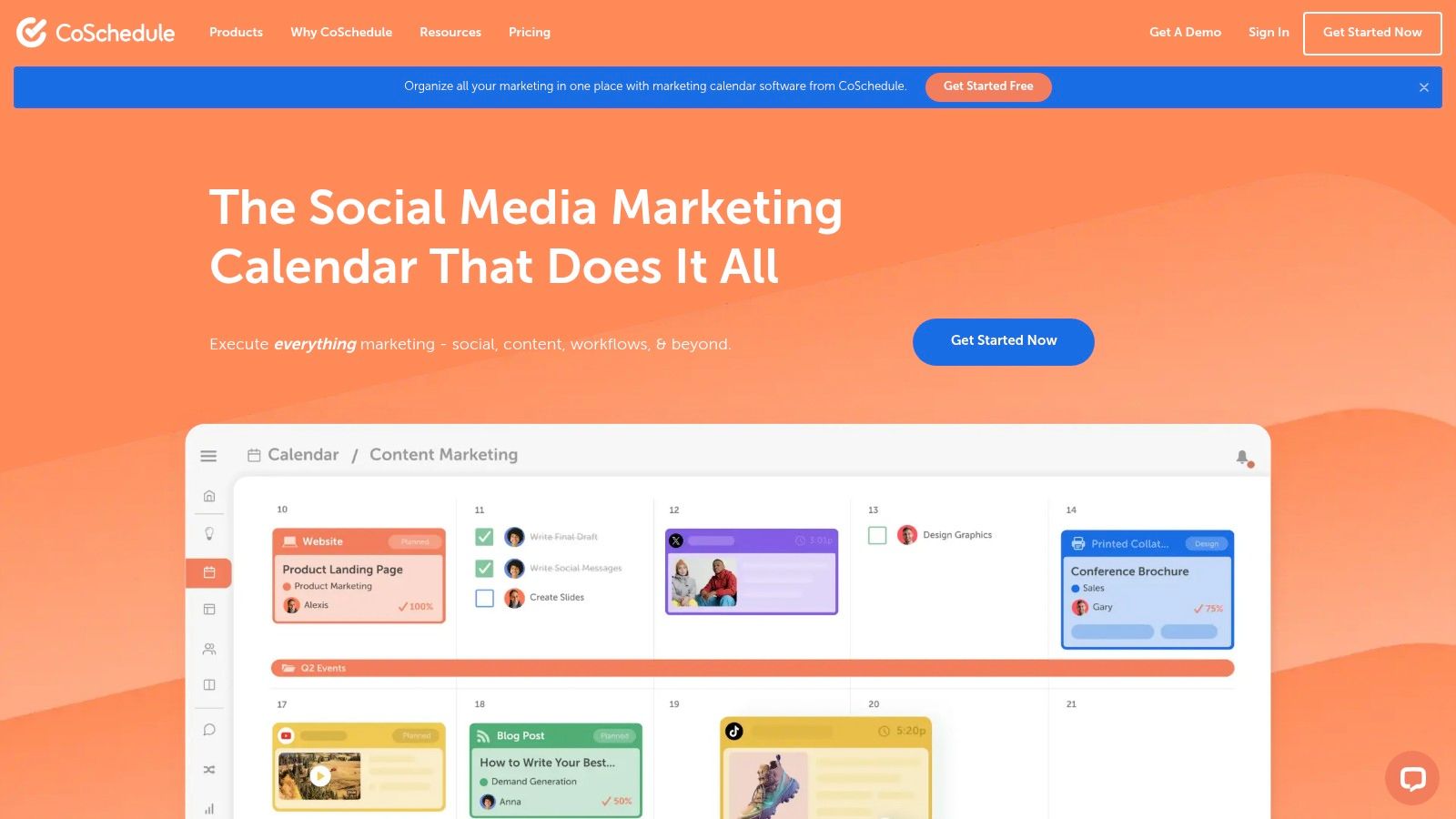
Core Features & Use Cases
The heart of CoSchedule is its Marketing Calendar. This feature allows teams to plan, create, and schedule all their marketing activities, from blog posts and email newsletters to social media campaigns, in one place. For instance, a content manager can map out an entire quarter's worth of blog topics, assign writers and designers specific tasks with deadlines, and then automatically schedule a series of promotional social media posts to go live the moment the blog is published, all from one central dashboard. Its integrations with WordPress and Google Docs streamline the workflow from draft to publication.
Pricing and Accessibility
CoSchedule provides a free plan which is excellent for individuals looking to organize their work and social media. The paid Marketing Calendar plans are geared towards professional marketers and teams, offering more advanced features and integrations. While the pricing is competitive for the value it offers in team organization, it can feel like a significant step up for solo creators or very small businesses who might not utilize the full suite of collaborative tools, potentially making the initial user experience feel overwhelming.
Practical Tip: Use CoSchedule's "Idea Board" to bank all your content ideas. This keeps your pipeline full and allows you to drag and drop ideas directly onto the calendar when you're ready to schedule them, ensuring you never run out of content and can plan strategically.
- Pros: Excellent for visualizing and managing the entire content calendar, strong task management features for teams, integrates with WordPress and Google Docs.
- Cons: Can be overwhelming for small teams or individual marketers, some users report a steep learning curve to master all features.
Website: https://coschedule.com/
6. Sprout Social
Sprout Social carves out its niche in the content automation landscape by focusing exclusively on social media management. It is a comprehensive platform designed for brands that need sophisticated tools for scheduling, monitoring, and analyzing their social presence. Unlike broader marketing suites, Sprout Social's strength lies in its depth, offering powerful social listening and reporting features that provide granular insights into audience engagement and campaign performance across multiple networks.
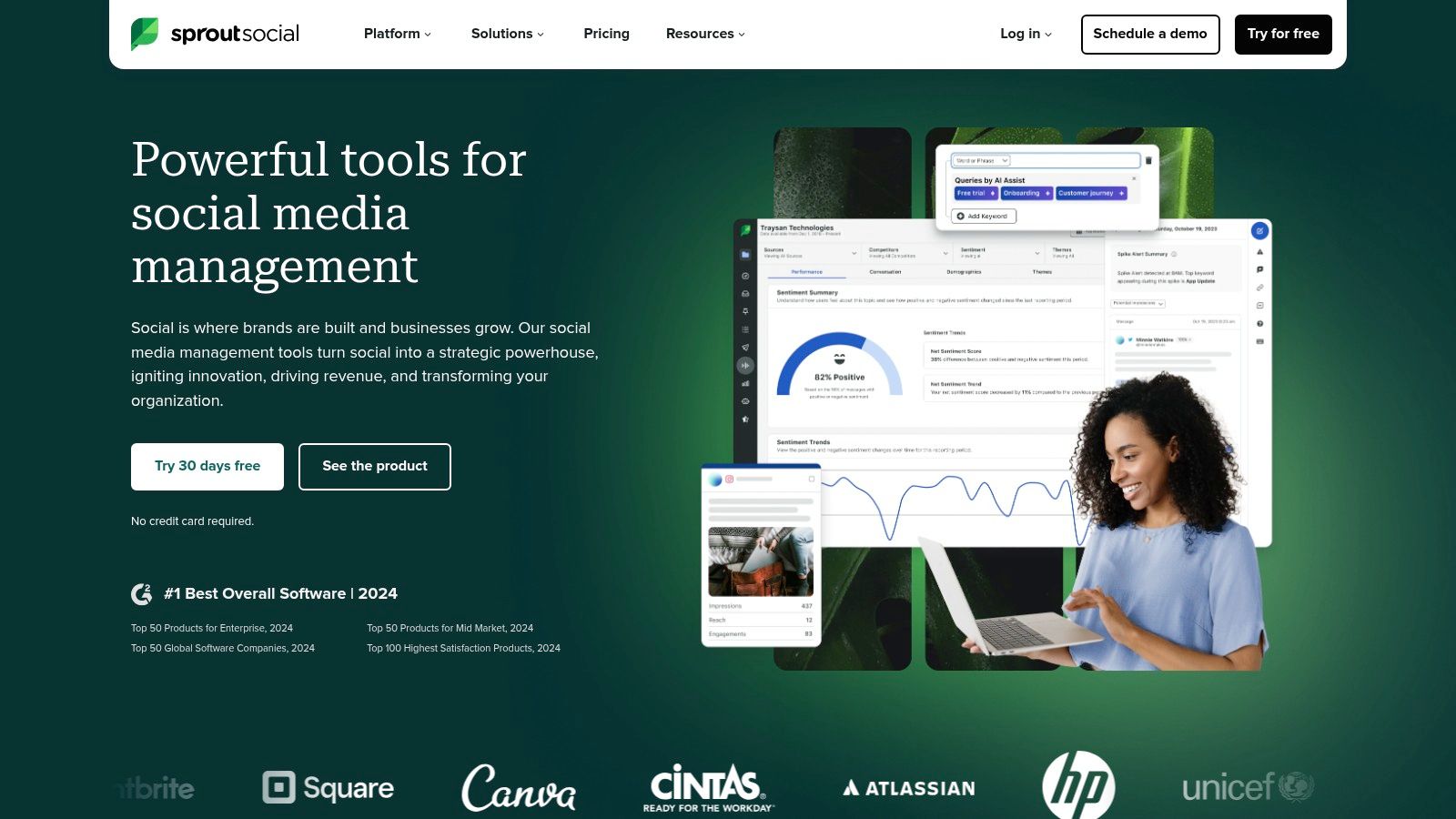
Core Features & Use Cases
The platform excels at automating the entire social media content lifecycle. Its content automation tools include an intuitive content calendar for planning and a "ViralPost" feature that automatically schedules posts for optimal engagement times based on audience activity. A key use case is brand monitoring; teams can use its social listening tools to track brand mentions, keywords, and hashtags in real-time, allowing for quick engagement with customers or a swift response to a PR crisis. This transforms social media from a simple broadcast channel into a two-way communication and intelligence-gathering tool.
Pricing and Accessibility
Sprout Social is positioned as a premium solution, and its pricing reflects that. Plans are offered on a per-user basis, starting with the Standard plan and scaling up to Advanced and Enterprise tiers. This model can become costly for larger teams, making it a better fit for mid-sized to large businesses with dedicated social media marketing budgets. A 30-day free trial is available, allowing teams to fully evaluate its capabilities before committing.
Practical Tip: Leverage the social listening features during your free trial to conduct a competitive analysis. Track your competitors' mentions and content performance to identify gaps in their strategy that you can exploit. This provides immediate value and helps justify the investment.
- Pros: Comprehensive social media management features, strong analytics and reporting capabilities, excellent customer support.
- Cons: More expensive than many competitors, primarily focused on social media, lacking other content types.
Website: https://sproutsocial.com/
7. Semrush
While widely known as an SEO powerhouse, Semrush has evolved into a comprehensive content marketing suite with powerful automation features. Its unique value lies in connecting data-driven SEO insights directly with the content creation process. Rather than creating content in a vacuum, Semrush ensures every piece is optimized for search visibility from the ground up, making it an indispensable tool for marketers focused on organic growth. It bridges the gap between keyword strategy and content execution.
Core Features & Use Cases
Semrush excels at automating the research and optimization phases of content creation. Its Topic Research tool can generate a full content plan around a single keyword, suggesting subtopics, headlines, and related questions to answer. The SEO Writing Assistant is one of its standout content automation tools, providing real-time feedback on readability, tone of voice, SEO, and originality directly within your Google Docs or WordPress editor. This allows writers to optimize content as they create it, streamlining the path from first draft to a high-ranking asset.
Pricing and Accessibility
Semrush operates on a subscription model with several tiers (Pro, Guru, Business). The entry-level Pro plan offers significant functionality, but access to the more advanced content marketing toolkit, including content audits and topic research, requires the Guru plan or higher. The platform's complexity can present a steep learning curve for beginners, though its extensive knowledge base and customer support help ease the transition.
Practical Tip: Use the SEO Content Template feature before writing. Enter your target keywords, and Semrush will analyze the top-ranking pages to provide actionable recommendations on text length, semantic keywords to include, and readability scores to aim for. This automates competitive analysis and gives your writers a clear, data-backed brief.
- Pros: Comprehensive SEO and content marketing tools, in-depth competitor analysis, and excellent real-time writing assistance.
- Cons: Can be overwhelming for beginners, and the most powerful content features are locked behind higher-priced tiers.
Website: https://www.semrush.com/
8. Mailchimp
Mailchimp is a household name in email marketing, but its evolution into a more comprehensive marketing platform makes it a key player in content automation. It excels by making sophisticated email automation accessible to businesses of all sizes, particularly those in e-commerce. Its unique strength lies in its user-friendly interface that simplifies the process of creating automated customer journeys, transforming one-time buyers into loyal brand advocates through timely, personalized communication.
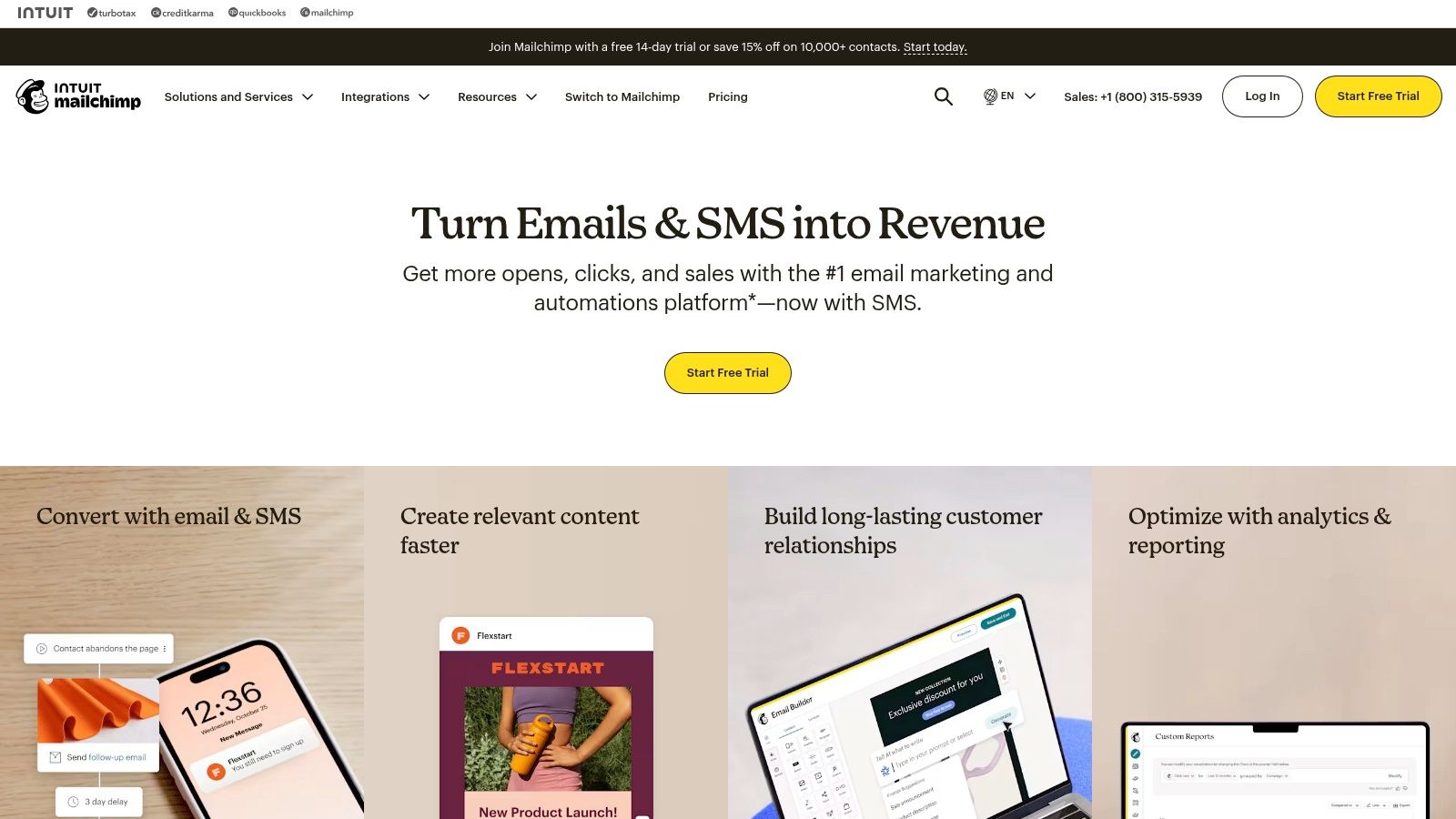
Core Features & Use Cases
At its core, Mailchimp’s suite of content automation tools is built around its Customer Journey builder. This feature allows you to visually map out automated communication paths based on user behavior. For example, you can automatically send a welcome email series to new subscribers, trigger a cart abandonment email for e-commerce shoppers, or send product recommendations based on past purchase history. The platform’s robust audience segmentation lets you deliver highly targeted content, ensuring your messages resonate with the right audience segments at the right time.
Pricing and Accessibility
Mailchimp offers a tiered pricing structure, including a limited free plan that is suitable for very small businesses or those just starting with email marketing. The paid plans (Essentials, Standard, and Premium) unlock progressively more advanced automation features, larger contact lists, and more sophisticated analytics. While the entry point is low, costs can escalate quickly as your audience grows and your automation needs become more complex, which is a critical consideration for scaling businesses.
Practical Tip: Leverage Mailchimp's powerful e-commerce integrations with platforms like Shopify or WooCommerce. Sync your customer and order data to create highly effective automated campaigns, such as post-purchase follow-ups or re-engagement emails for lapsed customers, driving significant repeat business.
- Pros: Very user-friendly email builder and workflow creator, powerful audience segmentation for targeted campaigns, excellent e-commerce integrations.
- Cons: Automation features in the free and basic plans are limited, costs can become high for advanced features and large contact lists.
Website: https://mailchimp.com/
9. ActiveCampaign
ActiveCampaign excels by blending powerful email marketing and marketing automation with a user-friendly CRM. Its core strength lies in its ability to create deeply personalized customer experiences based on behavior, interests, and lifecycle stage. Unlike platforms focused solely on content creation, ActiveCampaign specializes in automating the delivery of that content, making it a critical tool for nurturing leads and engaging customers through highly targeted communication.
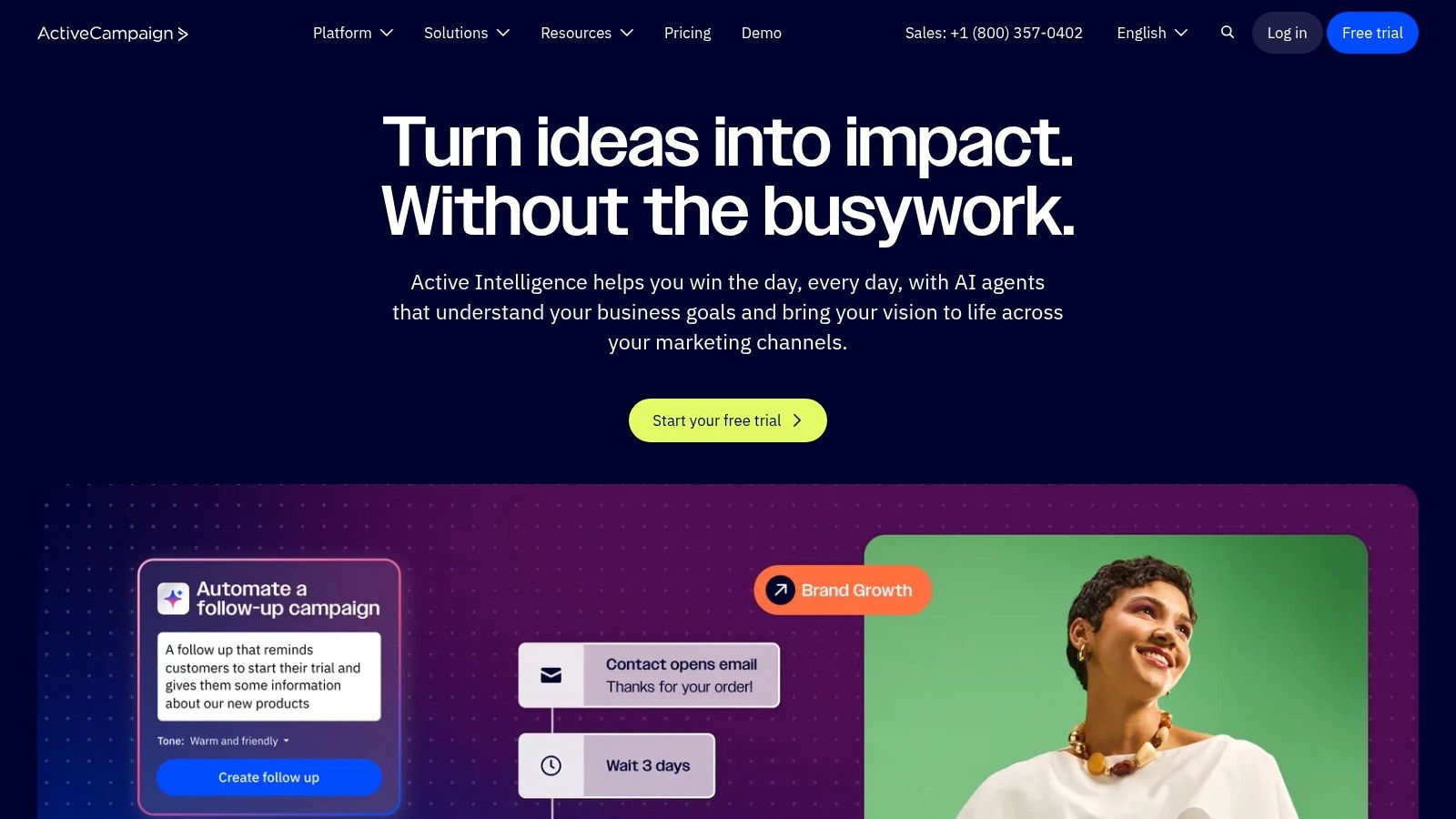
Core Features & Use Cases
The platform's visual workflow builder is where its content automation tools come to life. Users can design intricate automation sequences triggered by almost any action: a website visit, a form submission, an abandoned cart, or an email open. For example, you can automatically send a series of educational blog posts to a new subscriber, then segment them into a different campaign once they click a link indicating interest in a specific product category. Its CRM ensures all this activity is logged against a contact record, providing a complete view of the customer journey.
Pricing and Accessibility
ActiveCampaign's pricing is based on the number of contacts and the feature tier (Plus, Professional, Enterprise). While there is no free-forever plan, it offers a 14-day free trial to test its capabilities. The entry-level plans are accessible, but costs can escalate for businesses with large contact lists or those needing advanced features like predictive sending and split automations, making it a more significant investment.
Practical Tip: Map out your customer journey before you build your automations in ActiveCampaign. Knowing the key touchpoints and desired actions will help you leverage its powerful segmentation and conditional logic features effectively from day one.
- Pros: Advanced automation capabilities powered by AI, powerful segmentation for personalized communications, detailed reporting and analytics dashboards.
- Cons: Steeper learning curve for beginners, pricing can be high for businesses with a large contact list.
Website: https://www.activecampaign.com/
10. Quark
Quark specializes in enterprise-level content automation, moving beyond simple blog posts to tackle complex, structured documents like technical manuals, financial reports, and product datasheets. It shines in environments where compliance, accuracy, and brand consistency across intricate, data-heavy documentation are non-negotiable. Its unique value is its component-based approach, allowing teams to create, manage, and reuse individual pieces of content (components) across multiple documents and formats automatically.
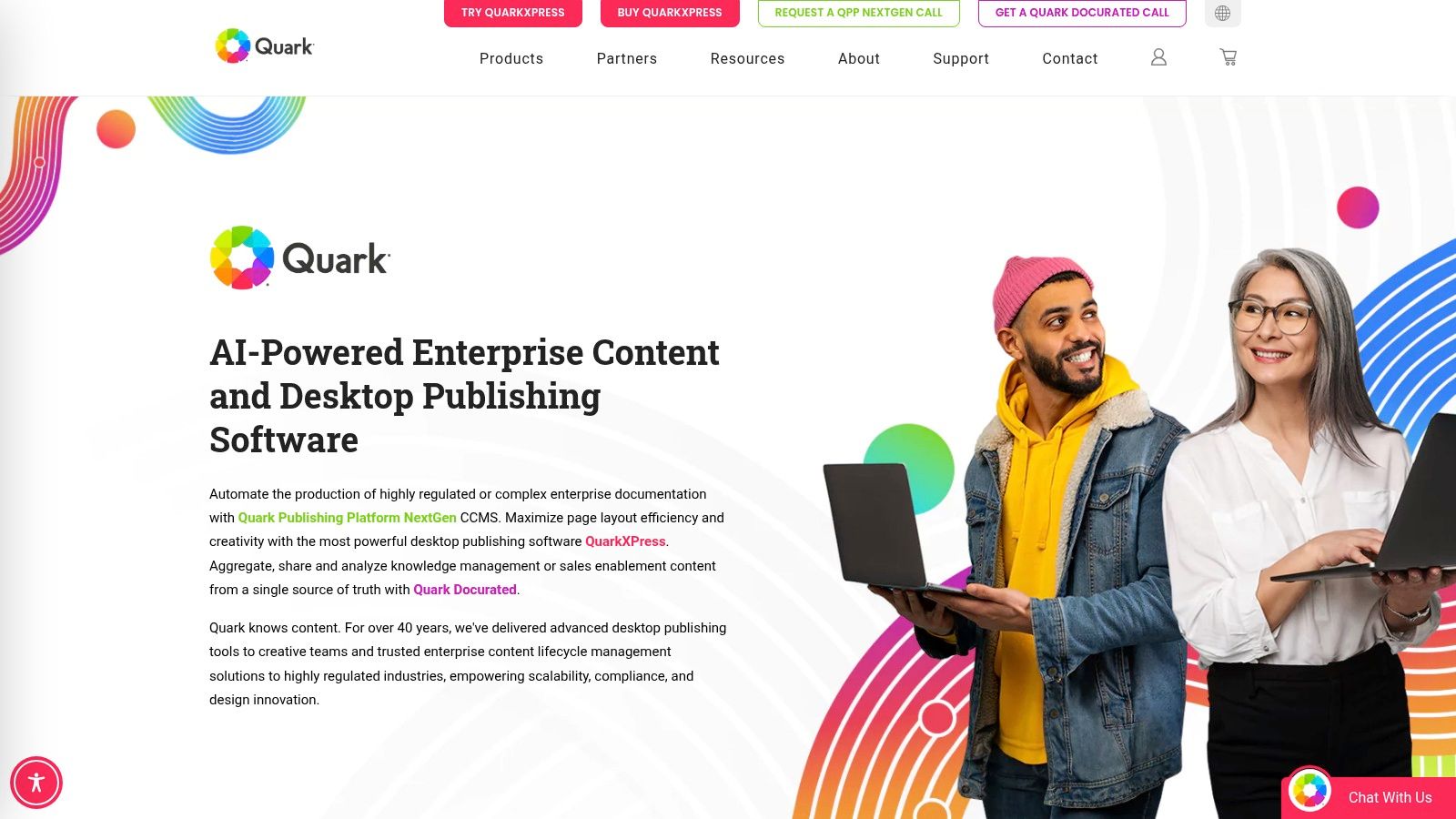
Core Features & Use Cases
Quark's content automation tools are built for scale and complexity. A core use case involves a global manufacturing firm creating technical documentation for a new product. Instead of manually writing separate guides for different regions, they can use Quark to manage content components. When a specification changes, they update one component, and the platform automatically propagates that change across all relevant manuals, web pages, and PDF downloads, ensuring consistency and saving hundreds of hours. Its robust collaboration and workflow tools support this process, managing approvals and versions seamlessly.
Pricing and Accessibility
Quark is an enterprise-grade solution, and its pricing reflects that. There are no public-facing pricing tiers; instead, Quark provides custom quotes based on the specific needs, scale, and integration requirements of a business. This makes it inaccessible for small businesses or individual creators but a powerful, tailored option for large organizations looking for a comprehensive content lifecycle management system. The platform often requires dedicated training and implementation support due to its depth.
Practical Tip: Quark is best suited for organizations dealing with highly regulated or complex structured content. Before engaging, clearly map your entire content lifecycle, from creation and review to publishing and archiving, to determine if its component-based authoring model aligns with your operational needs.
- Pros: Excellent for complex document management, powerful component-based authoring, ensures brand and regulatory compliance at scale.
- Cons: High cost and significant learning curve, limited customization in certain areas, overkill for standard marketing content.
Website: https://www.quark.com/
11. Writesonic
Writesonic positions itself as a premier AI-powered writing assistant, designed to significantly speed up the content creation process. Its core strength lies in its ability to generate high-quality, long-form content like blog posts and articles, as well as shorter copy for ads, product descriptions, and landing pages. Unlike some general-purpose AI writers, Writesonic is specifically tailored for marketers and content creators, offering templates and workflows that align with common marketing objectives. This focus makes it a powerful tool for teams needing to scale their content output without a proportional increase in headcount.
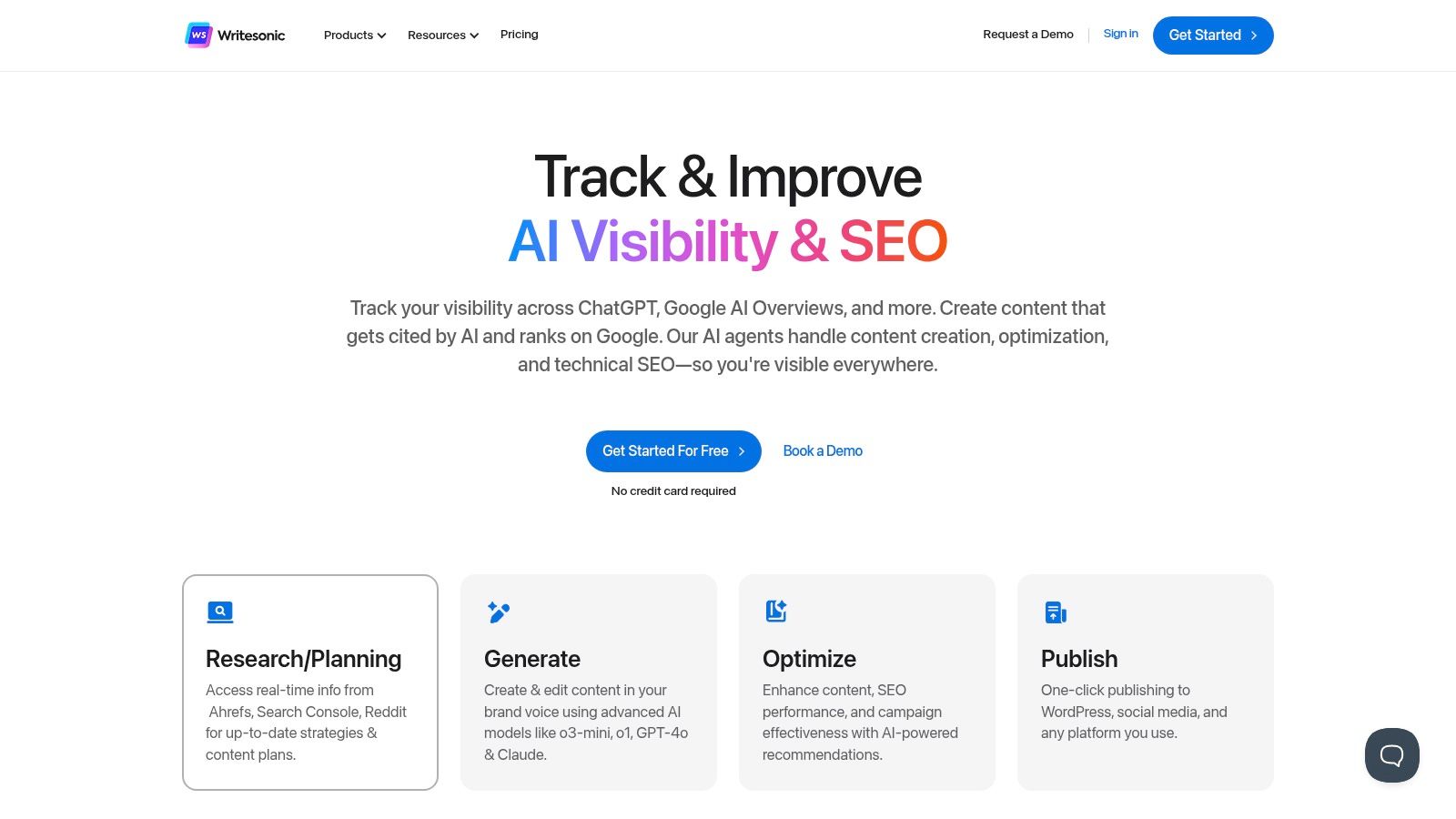
Core Features & Use Cases
Writesonic's platform is built around a suite of content automation tools powered by advanced AI. Users can leverage over 100 templates for specific tasks, from generating a complete blog post with its AI Article Writer 5.0 to crafting compelling copy for Google Ads or a high-converting landing page. A key feature is its SEO optimization suggestions, which help ensure the generated content is primed for search engine visibility. For instance, a content manager can use it to produce a draft of a 1,500-word article, complete with an outline and relevant keywords, in a matter of minutes. Explore how these tools can specifically enhance your website's landing pages.
Pricing and Accessibility
The platform offers a flexible pricing model, including a free trial that provides a limited number of words, allowing users to test its capabilities. Paid plans are tiered based on word count, user seats, and access to premium features like Photosonic (AI image generation) and Audiosonic (text-to-speech). This structure makes it accessible for freelancers and small teams, while also offering enterprise-level plans for larger organizations, making it a scalable solution.
Practical Tip: Use Writesonic for initial drafts and brainstorming. While it can generate impressive content quickly, the best results come from using the AI-generated text as a foundation and then having a human editor refine the tone, check facts, and add unique insights.
- Pros: Extremely fast content generation, intuitive user-friendly interface, supports a wide variety of content formats and templates.
- Cons: Generated content always requires manual editing for brand voice and accuracy, customization options can feel limited for highly specific niches.
Website: https://writesonic.com/
Content Automation Tools Feature Comparison
| Solution | Core Features / Capabilities | User Experience & Quality ★ | Value & Pricing 💰 | Target Audience 👥 | Unique Selling Points ✨ |
|---|---|---|---|---|---|
| 🏆 rebelgrowth | AI blog posts, backlink exchange, AI social posts scheduling, full-service digital marketing | ★★★★☆ Expert-backed content, multi-language support | From $59/month 💰 Flexible plans | Entrepreneurs, marketers, business owners 👥 | Done-for-you AI + expert strategy, integrates with WordPress, Shopify, Wix ✨ |
| HubSpot | All-in-one marketing, CRM, SEO, email & social media automation | ★★★★☆ Robust analytics & CRM integration | Higher cost 💰 Enterprise focus | Medium to large businesses 👥 | Comprehensive platform with CRM focus ✨ |
| Hootsuite | Social media scheduling, content curation, team collaboration, analytics | ★★★★☆ Easy multi-account management | Moderate to high 💰 | Social media managers, agencies 👥 | Strong social media content curation ✨ |
| Buffer | Social media post scheduling, analytics, team collaboration | ★★★☆☆ Simple, intuitive mobile-friendly | Affordable 💰 Small businesses | Small businesses, solo marketers 👥 | Easy to use, mobile focus ✨ |
| CoSchedule | Marketing calendar, task management, social media scheduling | ★★★★☆ Visual content planning & team coordination | Moderate 💰 | Marketing teams, agencies 👥 | Powerful calendar + task management ✨ |
| Sprout Social | Social media scheduling, content calendar, analytics, social listening | ★★★★☆ Deep insights & customer support | Higher price 💰 | Brands with heavy social media needs 👥 | Advanced analytics + social listening ✨ |
| Semrush | SEO keyword research, content optimization, competitor analysis | ★★★★☆ In-depth SEO tools & reports | Higher pricing tiers 💰 | SEO specialists, marketers 👥 | Comprehensive SEO & competitor analysis ✨ |
| Mailchimp | Email marketing automation, segmentation, e-commerce integration | ★★★☆☆ User-friendly email workflows | Free to moderate 💰 | E-commerce, small businesses 👥 | Strong email marketing & segmentation ✨ |
| ActiveCampaign | Marketing automation, CRM, personalization, AI workflows | ★★★★☆ Advanced AI workflows, detailed analytics | Mid to high 💰 | Businesses needing automation & CRM 👥 | AI-powered automation + personalization ✨ |
| Quark | Content automation, collaboration, templates, integrations | ★★★☆☆ Simplifies content creation | Moderate 💰 | Content teams, marketers 👥 | Workflow automation & real-time collaboration ✨ |
| Writesonic | AI content generation, SEO suggestions, templates | ★★★☆☆ Fast content creation | Moderate 💰 | Content creators, marketers 👥 | Rapid AI-driven content generation ✨ |
Automate, Elevate, and Dominate Your Content Strategy
Navigating the landscape of modern content marketing reveals a clear, undeniable trend: the future is automated. As we've explored throughout this comprehensive guide, the days of juggling every content task manually are numbered. The strategic adoption of content automation tools is no longer a luxury for large enterprises; it's a critical component for entrepreneurs, business owners, and marketers aiming to scale their efforts, improve efficiency, and drive meaningful traffic.
We’ve dissected a range of powerful platforms, from all-in-one SEO content engines like rebelgrowth and HubSpot to specialized social media schedulers like Hootsuite and Buffer. We also examined email marketing powerhouses such as Mailchimp and ActiveCampaign, and the impressive AI writing capabilities of tools like Writesonic. Each tool offers a unique solution to a specific set of content challenges, proving there is a perfect fit for nearly every business model and budget. The core takeaway is this: automation liberates your team from repetitive, low-impact tasks, freeing up valuable human capital for high-level strategy, creativity, and customer engagement.
Choosing Your Automation Ally: A Practical Framework
Selecting the right platform from our list can feel overwhelming, but the decision becomes clearer when you ground it in your specific business needs. Don't chase the tool with the most features; instead, identify your primary bottleneck and choose the tool that solves it most effectively.
To guide your decision, consider these key factors:
- Primary Goal: Are you focused on SEO and organic traffic, social media engagement, or lead nurturing through email? Your primary objective will immediately narrow the field. For instance, if dominating search rankings is your top priority, a tool like rebelgrowth or Semrush is a logical starting point.
- Team Size and Skillset: A solo entrepreneur needs a user-friendly, all-in-one solution, whereas a larger marketing team might benefit from a more complex, specialized platform like Sprout Social or CoSchedule that offers advanced collaboration features.
- Integration Capabilities: Your new tool must play well with your existing technology stack. Before committing, verify that it integrates seamlessly with your CRM, CMS (like WordPress), analytics platforms, and other essential software. This prevents data silos and ensures a smooth, unified workflow.
- Scalability: Choose a tool that can grow with you. Consider its pricing tiers, feature upgrades, and ability to handle increased content volume and team members as your business expands. A platform that seems affordable now may become restrictive later.
Implementation: From Tool Selection to Tangible Results
Once you've chosen your ideal set of content automation tools, successful implementation is paramount. It’s not just about turning on the software; it's about integrating it into your strategy.
Start by automating one or two high-impact, time-consuming processes. For example, begin by scheduling all your social media posts for the week or setting up a welcome email sequence for new subscribers. This allows your team to adapt without feeling overwhelmed. Furthermore, remember that automation should augment, not replace, human oversight. AI-generated content still requires a human editor to ensure brand voice, accuracy, and originality.
The scope of automation is constantly expanding. For those heavily invested in video marketing, even niche tasks are becoming easier to automate. For example, specialized AI-powered YouTube description generators can craft optimized, engaging descriptions in seconds, freeing up creators to focus on producing high-quality video content. This is a prime example of how targeted automation can streamline specific parts of your workflow.
Ultimately, the goal of integrating these tools is to build a resilient, efficient content ecosystem. By automating the mechanics of content distribution, optimization, and analysis, you empower your team to focus on what humans do best: building relationships, understanding audience needs, and creating truly exceptional, valuable content that resonates. The path to dominating your niche is paved with smart strategy and powerful technology. Embrace automation, and you’ll not only keep pace with the competition, you’ll lead the charge.
Tired of juggling spreadsheets, keyword tools, and disjointed content workflows? rebelgrowth is the all-in-one content automation platform designed to manage your entire SEO content lifecycle, from keyword clustering and AI-powered writing to automated publishing and performance tracking. Stop wrestling with tools and start dominating the SERPs by visiting rebelgrowth to see how you can put your content strategy on autopilot.
